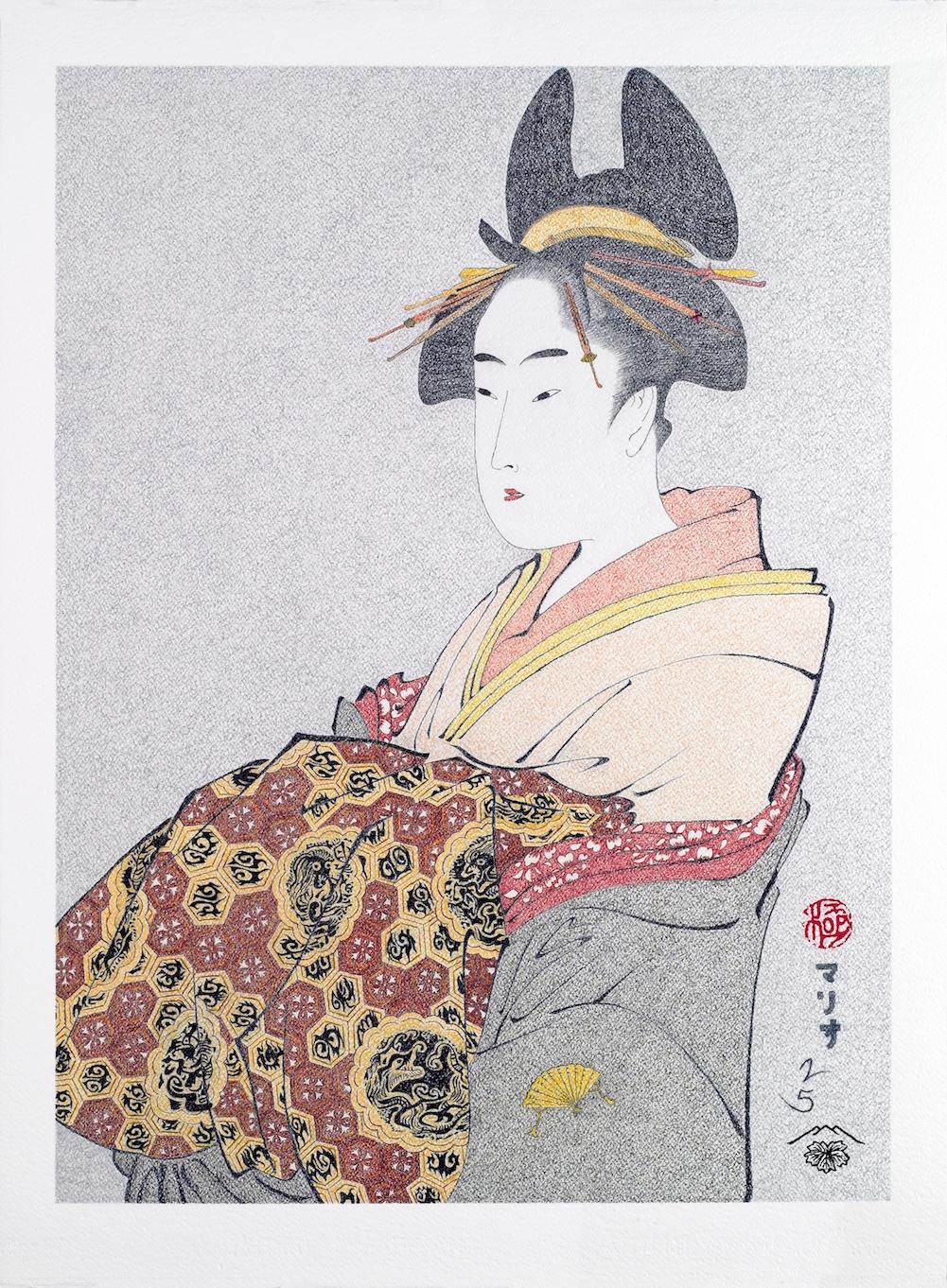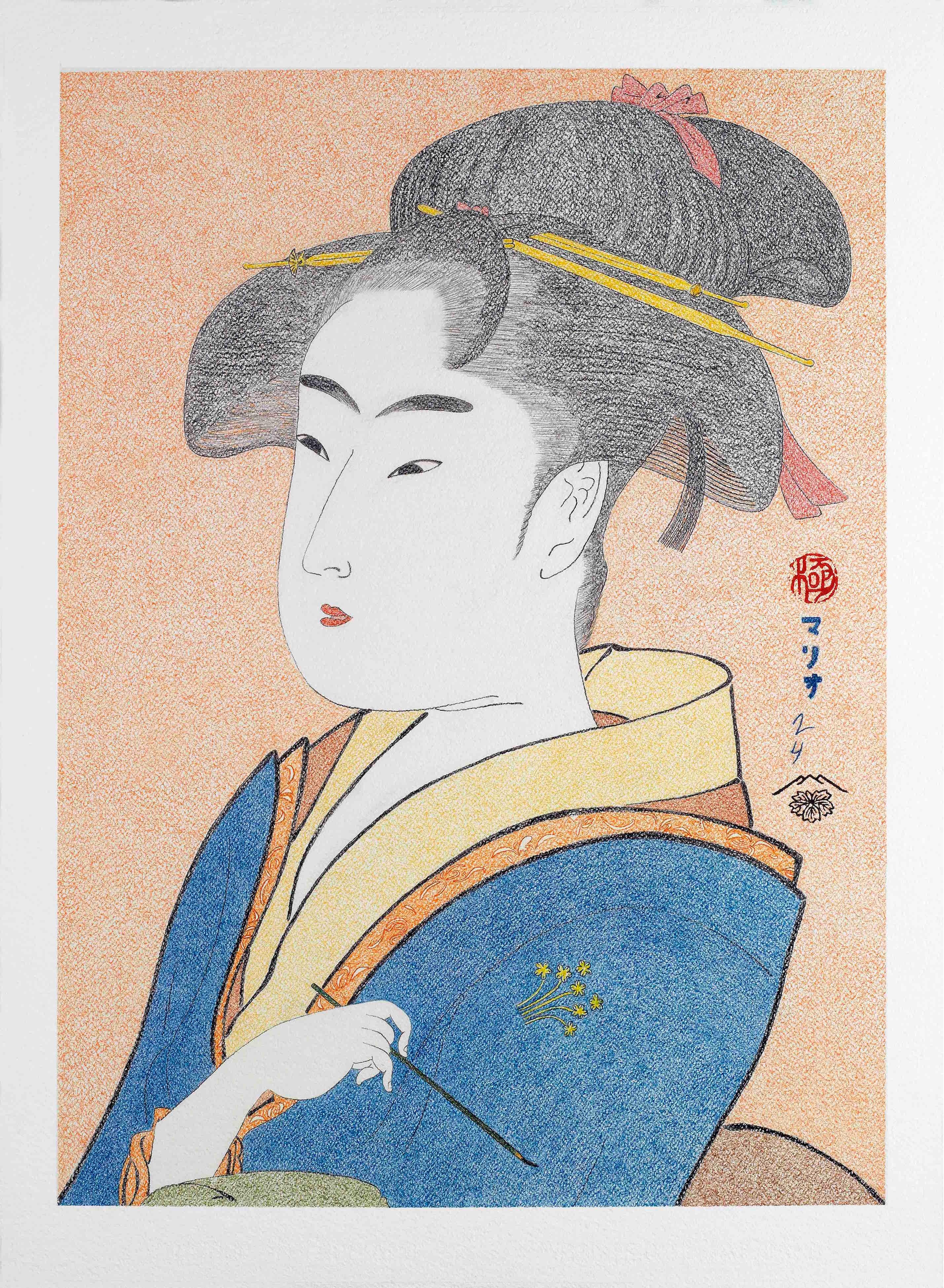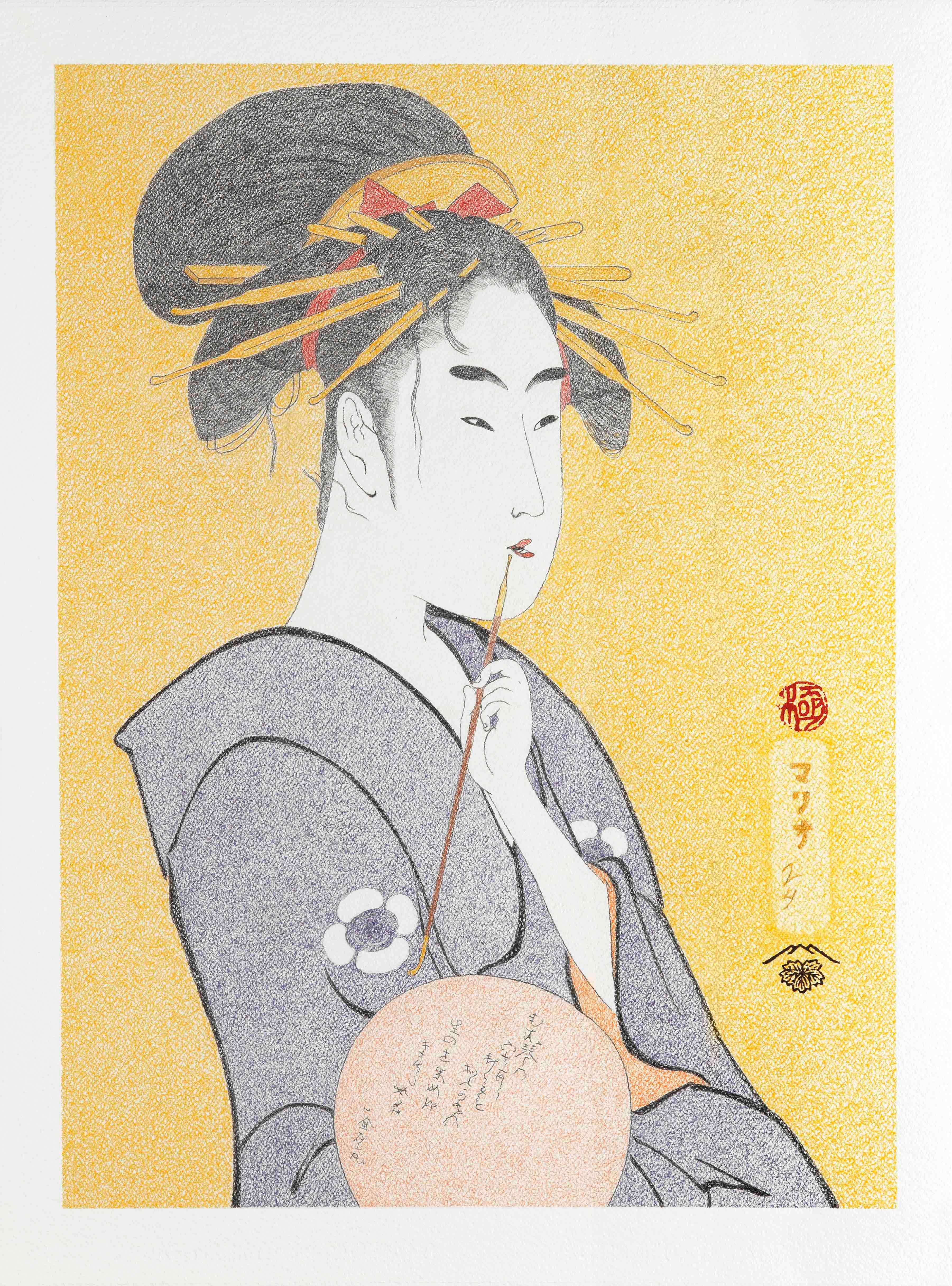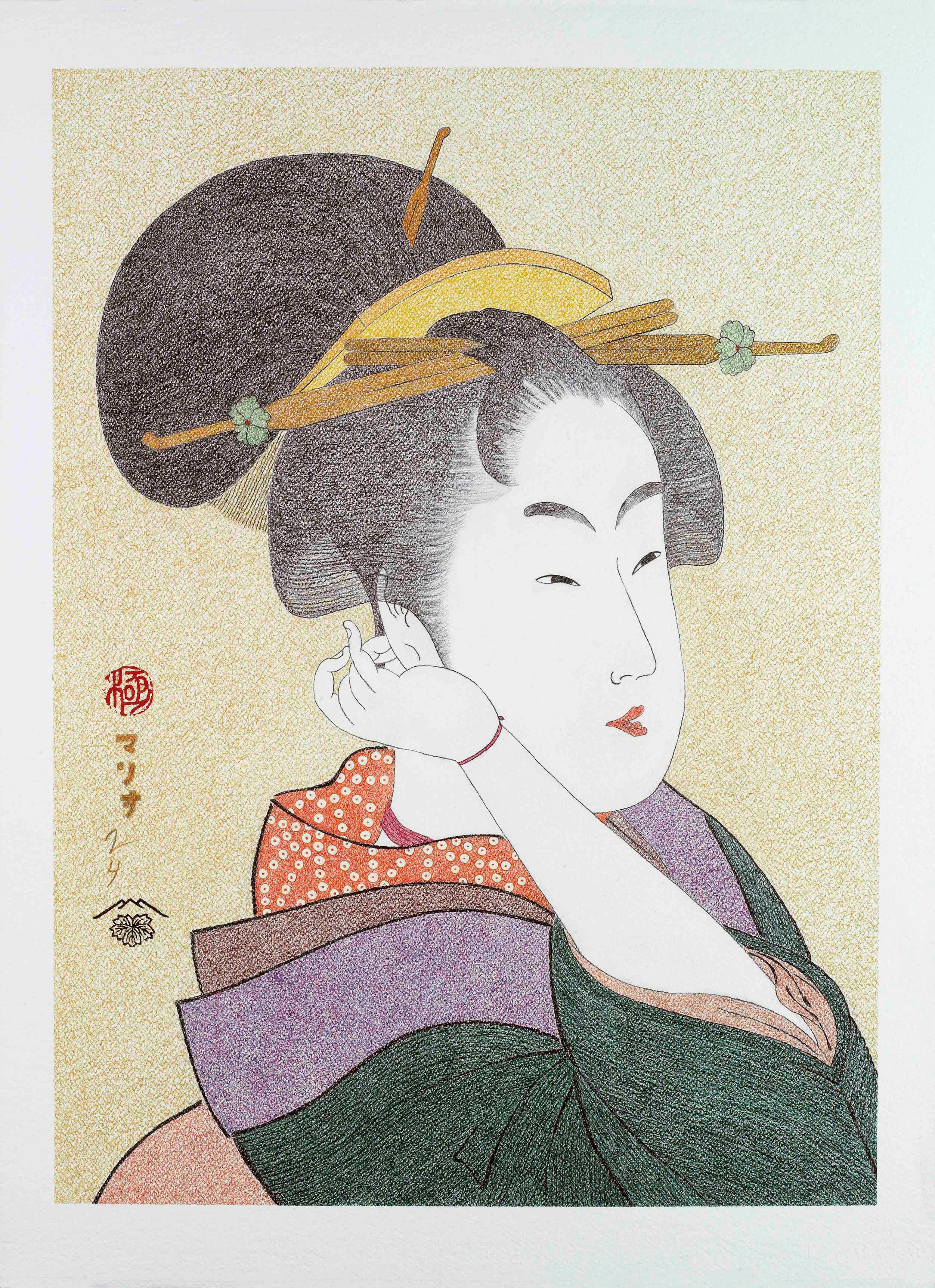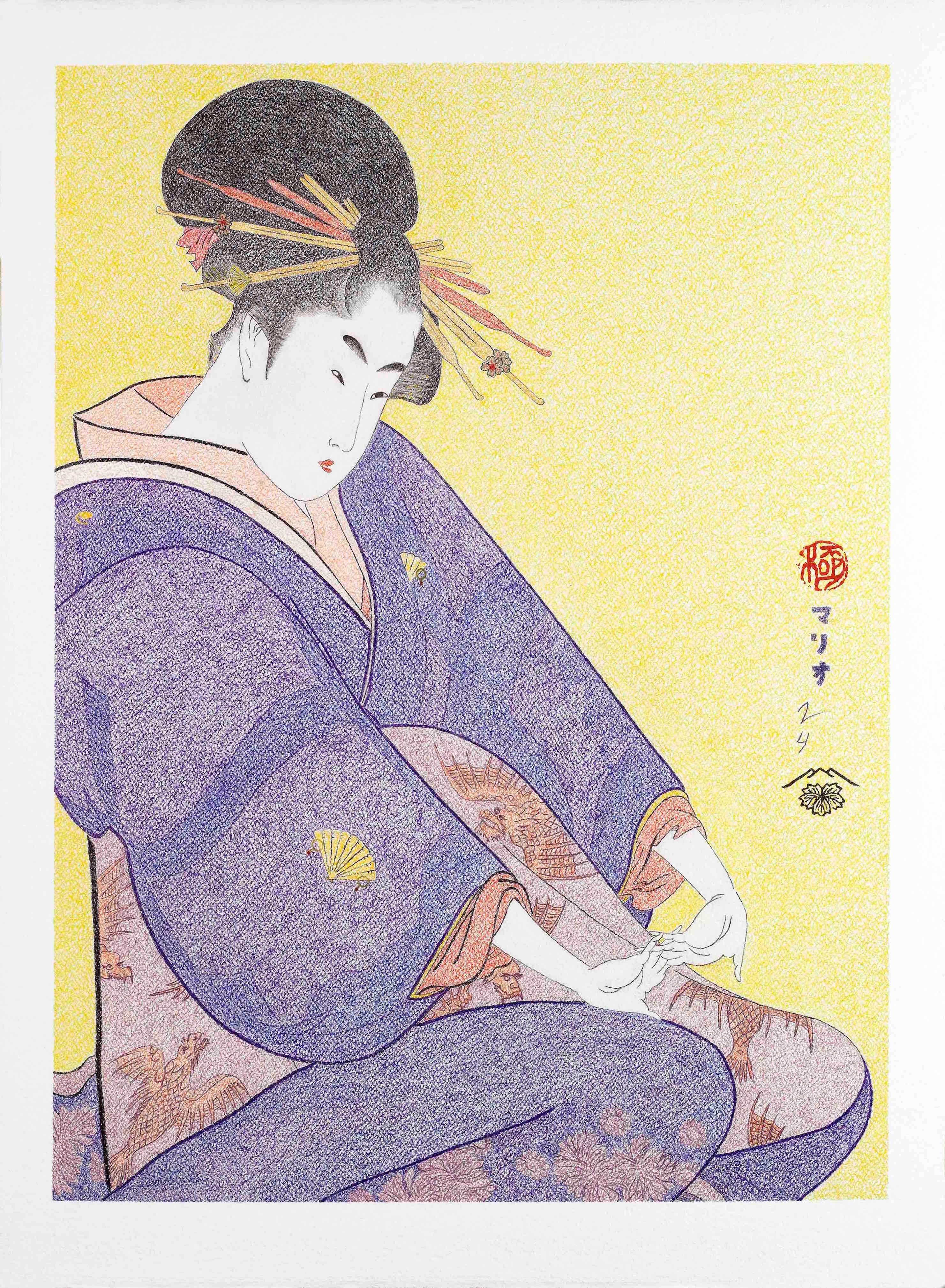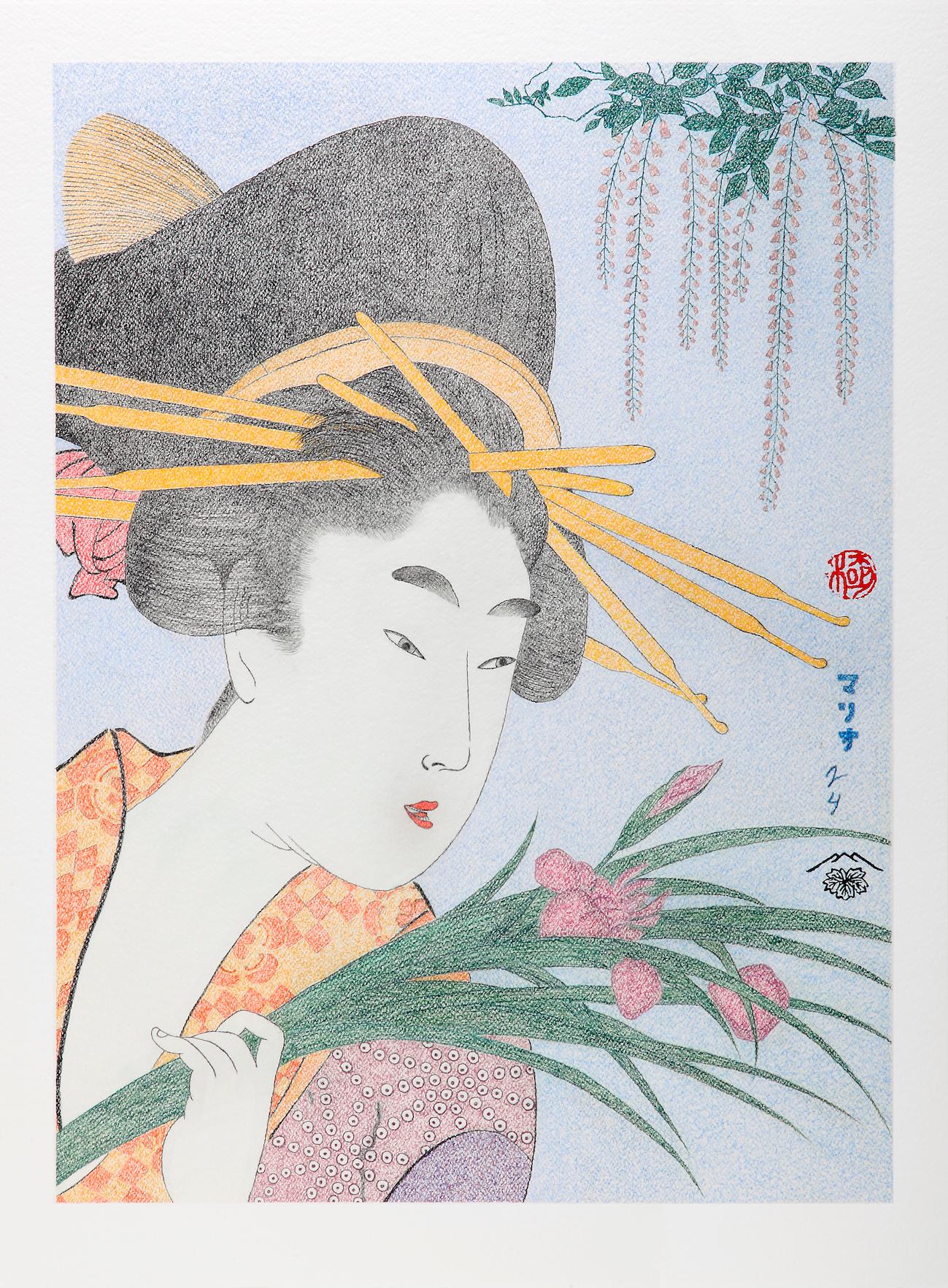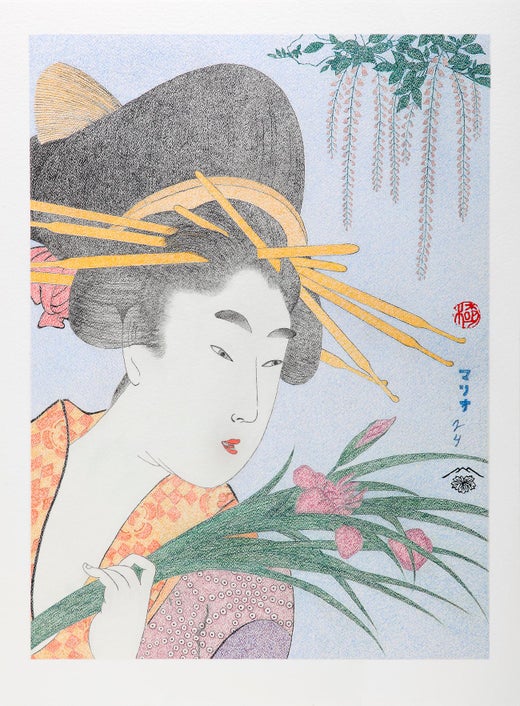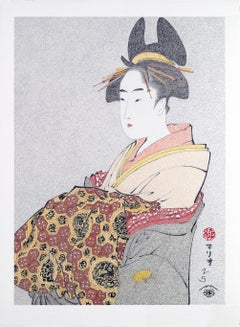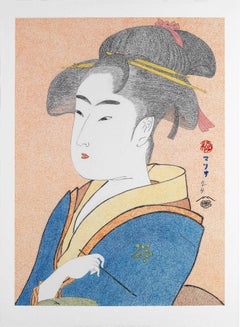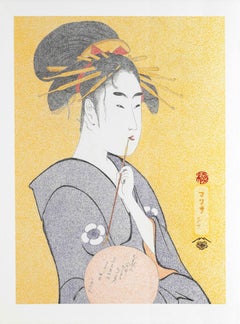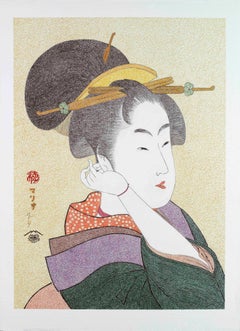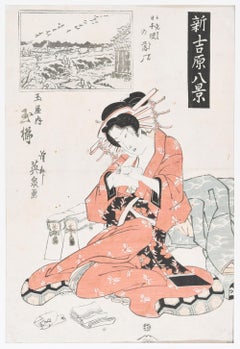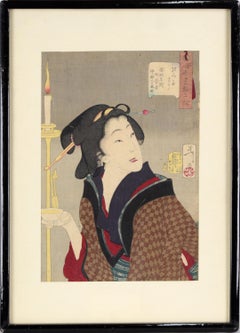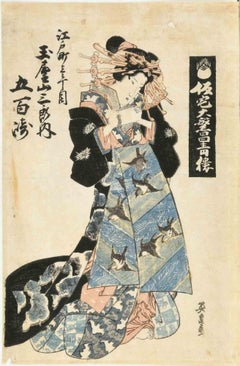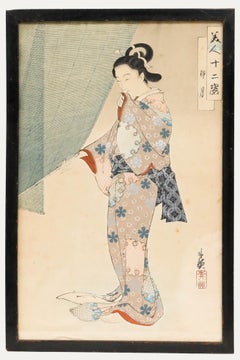Items Similar to Japanese Art Ukiyo-e Figurative painting, Courtesan Hanaôgi, Edo period
Want more images or videos?
Request additional images or videos from the seller
1 of 11
Mario B. GilJapanese Art Ukiyo-e Figurative painting, Courtesan Hanaôgi, Edo period2014
2014
$5,915.69
£4,430.66
€4,990
CA$8,303.62
A$9,083.22
CHF 4,732.47
MX$109,291.49
NOK 59,930.49
SEK 56,268.98
DKK 38,008.32
About the Item
Bijin-ga Series XXVI (Nº 26)
Title: Hanaôgi of the Ôgiya House
Hanaôgi, one of the most famous courtesans of the Edo period working in the Ôgiya House, an exclusive brothel in the Yoshiwara appears beautifully dressed holding a writing brush on her right hand and a decorated piece of paper in the shape of a “cartuche”, maybe to write a message of love for a client.
This image is part of the bijin-ga series (“Pretty women”) drawn by Mario BGil, based in the Kitigawa Utamaro woodblock print Hanaôgi of the Ôgiya House (1793-94), 22,05 x 29,92 cm. Museum of Fine Arts, Boston, USA.
The artist reproduces the seal of the censor (Kiwame) and from the original publisher (Tsutaya, climbing leaf)), between the two, the signature of Mario BGil written in Japanese, with the date 14 (2014).
The mesaurements of the drawing are 76 x 56 cm. (29,92 x 22,05 in.), with a painted surface of 67 x 49,5 cm. Framed: 85 (H) x 65 (W) x 3.5 (D) cm. The frame has a museum glass, which does not reflect. This piece cannot be exported outside of Europe to prevent risks with framing.
With his work on the bijing-ga series, Mario BGil wanted to embellish, give brilliance and volume to the images presented by japanese artist Kitigawa Utamaro in those beautiful engravings, ennobled with the patina of time, which have served as inspiration. The result obtained is almost life-size portraits, endowed with strong chromaticism and valuable contrasts, all enhanced, in turn, with the volume provided by the weight and rigidity of the paper, and its thick texture (Fabriano Artistico “grana grosso”, 640g/m2; the thickness and hardness of the paper makes it necessary to transport it without rolling). As this piece is framed, it cannot be exported outside of Europe to prevent risks with framing.
In this way, Mario BGil pays tribute to his admired artist and offers us a new and enriched vision of this popular facet of oriental art from the 18th and 19th centuries.
ABOUT THE ARTIST
Mario BGil is a self-taught artist who for years has combined his creative activity with his work in the business world, away from commercial art galleries. Man of very diverse interests and great artistic sensitivity, studied Art History and in 2012, a deep interest in oriental art was awakened in him so that he began to study the great masters of Japanese Ukiyo-e prints, who had such an influence on the European avant-garde of the late 19th century.
The discovery of Kitagawa Utamaro (1753-1806), a key figure in the metropolitan culture of Edo (now Tokyo), and a point of reference in the history of Japanese engraving, meant for Mario a change of course caused by the imperative need to study his images, recreate them and recreate himself in them, incorporating certain changes in both the format and the technique used.
The technique used by MBG is very different from that used in engravings with wooden blocks impregnated in inks of intense colors that serve as a model. On a paper of heavy weight and thick texture, Mario BGil outlines with a black pencil, and colors the spaces with pencils and watercolors. Faced with the intensity of color of the prints (already very lost in some of them due to their age and exposure to the sun), their drawings are sifted by the streaky white, due to the thick texture of the paper, showing more lines, soft and warmer tones, giving color to the backgrounds but leaving all the volumes corresponding to the skin blank, thus giving the figures a classic serenity that transcends their oriental character.
Between 2014 and 2015, Mario BGil made more than 35 drawings based on the prints selected from the huge amount of work produced by the master Utamaro that shows images of courtesans in different attitudes and poses that highlight the subtle delicacy of oriental feminine beauty.
Kitagawa Utamaro was a faithful representative of the tastes of the Japanese bourgeoisie of its time, which had transformed the life of the cities giving birth to a culture parallel to the official and aristocratic.
The activity of the new rising group took place in special neighborhoods of Edo (Tokyo) and Osaka and its banality, inconsistency and frivolity earned it the name of Ukiyo: "floating world"; a world that will give priority to a series of cultural manifestations much more popular and less intellectualized than those preferred by the nobility. The new neighborhoods are filled with brothels and shows that the upper classes will consider vain, and a new breed of heroes: sumo wrestlers, singers, actors and courtesans will come to reign in this "floating world."
In front of the traditional painting the stamp arises with images of this new world. The courtesans of the pleasure districts of Edo that Utamaro portrays, do not always appear perfectly dressed to receive the client, but are surprised while getting ready, or during the day. He observes them without being seen, spy on them in their daily and intimate work. All of them are women drawn in a similar style, with elongated faces, straight delicate noses (almost a single line) and other features reduced to a mere suggestion (the mouth, a tiny butterfly of red).
The importance that it has had in later European artists (Degas, Toulouse-Lautrec, Bonnard, Gauguin, Van Gogh ...) has been great and Mario BGil has not been able to escape the recreation of those images so classic and, at the same time, so current, paying clear tribute to its original creator.
- Creator:Mario B. Gil (1962)
- Creation Year:2014
- Dimensions:Height: 34.65 in (88 cm)Width: 26.38 in (67 cm)Depth: 1.38 in (3.5 cm)
- Medium:
- Movement & Style:
- Period:
- Condition:The real condition is New, but the artist framed it to show it off in his own home. The frame has a museum glass, which does not reflect. This piece cannot be exported outside of Europe to prevent risks with framing.
- Gallery Location:Segovia, ES
- Reference Number:1stDibs: LU74438889412
BIOGRAPHY Mario BGil is a self-taught artist who for years has combined his creative activity with his work in the business world, away from commercial art galleries. Man of very diverse interests and great artistic sensitivity, studied Art History and in 2012, a deep interest in oriental art was awakened in him so that he began to study the great masters of Japanese Ukiyo-e prints, who had such an influence on the European avant-garde of the late 19th century. The discovery of Kitagawa Utamaro (1753-1806), a key figure in the metropolitan culture of Edo (now Tokyo), and a point of reference in the history of Japanese engraving, meant for Mario a change of course caused by the imperative need to study his images, recreate them and recreate himself in them, incorporating certain changes in both the format and the technique used. The technique used by MBG is very different from that used in engravings with wooden blocks impregnated in inks of intense colors that serve as a model. On a paper of heavy weight and thick texture, Mario BGil outlines with a black pencil, and colors the spaces with pencils and watercolors. Faced with the intensity of color of the prints (already very lost in some of them due to their age and exposure to the sun), their drawings are sifted by the streaky white, due to the thick texture of the paper, showing more lines, soft and warmer tones, giving color to the backgrounds but leaving all the volumes corresponding to the skin blank, thus giving the figures a classic serenity that transcends their oriental character. Between 2014 and 2015, Mario BGil made more than 35 drawings based on the prints selected from the huge amount of work produced by the master Utamaro that shows images of courtesans in different attitudes and poses that highlight the subtle delicacy of oriental feminine beauty. Kitagawa Utamaro was a faithful representative of the tastes of the Japanese bourgeoisie of its time, which had transformed the life of the cities giving birth to a culture parallel to the official and aristocratic. In front of the traditional painting, the stamp arises with images of this new world. The courtesans of the pleasure districts of Edo that Utamaro portrays, do not always appear perfectly dressed to receive the client but are surprised while getting ready, or during the day. He observes them without being seen, and spies on them in their daily and intimate work. All of them are women drawn in a similar style, with elongated faces, straight delicate noses (almost a single line), and other features reduced to a mere suggestion (the mouth, a tiny butterfly of red). The importance that it has had in later European artists (Degas, Toulouse-Lautrec, Bonnard, Gauguin, Van Gogh ...) has been great and Mario BGil has not been able to escape the recreation of those images so classic and, at the same time, so current, paying clear tribute to its original creator.
About the Seller
5.0
Vetted Professional Seller
Every seller passes strict standards for authenticity and reliability
Established in 2002
1stDibs seller since 2017
69 sales on 1stDibs
Typical response time: 1 hour
- ShippingRetrieving quote...Shipping from: Bilbao, Spain
- Return Policy
Authenticity Guarantee
In the unlikely event there’s an issue with an item’s authenticity, contact us within 1 year for a full refund. DetailsMoney-Back Guarantee
If your item is not as described, is damaged in transit, or does not arrive, contact us within 7 days for a full refund. Details24-Hour Cancellation
You have a 24-hour grace period in which to reconsider your purchase, with no questions asked.Vetted Professional Sellers
Our world-class sellers must adhere to strict standards for service and quality, maintaining the integrity of our listings.Price-Match Guarantee
If you find that a seller listed the same item for a lower price elsewhere, we’ll match it.Trusted Global Delivery
Our best-in-class carrier network provides specialized shipping options worldwide, including custom delivery.More From This Seller
View AllJapanese Art Ukiyo-e Figurative Painting, Miyahito of The Ôgiya, Edo Period
Located in Segovia, ES
Bijin-ga Series XXXIV (Nº 34)
Title: Miyahito of the Ôgiya
Three quarter portrait of the elegant courtesan Miyahito of the Ôgiya House. This beautifully dressed japanese woman wears a solid grey outer robe, which contrasts with her soft rose kimono and the colored obi with an intricate geometric pattern. Her hair is arranged high atop her head, adorned with several hairpins. A classic Utamaro beauty print recreated with extraordinary taste and subtlety by Mario BGil in this delicate drawing.
This image is part of the bijin-ga series (“Pretty women”) drawn by Mario BGil, based in the Kitigawa Utamaro woodblock print...
Category
2010s Edo Figurative Drawings and Watercolors
Materials
Paper, Crayon, Oil Crayon, Graphite
Japanese Art Ukiyo-e Figurative Painting, Tomimoto Toyohina, Edo period
Located in Segovia, ES
Bijing-Ga series XXVII (Nº 27)
Title: Tomomoto Toyohina
Tomimoto Toyohina was a much sought-after geisha (entertainer) who performed narrative ballads accompanied by the shamisen. She was one of several non-prostitute beauties, including teahouse waitresses, whom Utamaro depicted repeatedly in the early to mid 1790s. She appears here with a brush in hand, dressed and combed with simple elegance.
This composition is from a six-print series comprising half-length portraits of famous beauties (Famous beauties of Edo).
Utamaro elevated Tomimoto Toyohina to the status of one of the three most renowned beauties of her age (together with Okita and Ohisa). She was from a prominent family of musicians that provided entertainment in the Yoshiwara. Toyohina’s appeal undoubtedly was as much due to her appearance as to her skills in singing, and Utamaro’s celebration of her would have further elevated the status of an already well-known lineage.
This image is part of the bijin-ga series (“Pretty women”) drawn by Mario BGil, based in the Kitigawa Utamaro woodblock print...
Category
2010s Edo Figurative Drawings and Watercolors
Materials
Paper, Crayon, Oil Crayon, Graphite
Japanese Art Ukiyo-e Figurative Painting, The courtese Hinakoto, Edo period
Located in Segovia, ES
Bijin-ga series XXI (Nº 21)
Title: The courtese Hinakoto of the Hyôgorô House of Edo
The courtesan Hinakoto is depicted by smoking tobacco. She takes the pipe delicately in her left hand and, in her right hand, she seems to be holding a “uchiwa” (rigid hand fan) that comes out from the bottom of the drawing, decorated with written calligraphy. Some strands of hair that fall on her temple and her scant clothing show that the painter has surprised her in a relaxed moment in which she does not lose her elegance and slenderness.
This image is part of the bijin-ga series (“Pretty women”) drawn by Mario BGil, based in the Kitigawa Utamaro woodblock print...
Category
2010s Edo Figurative Drawings and Watercolors
Materials
Crayon, Paper, Oil Crayon, Graphite
Japanese Art Ukiyo-e Figurative Painting, Tatsumi Roko, Edo Period
Located in Segovia, ES
Bijin-ga series XXVIII (Nº 28)
Title: Tatsumi Roko
Portrait of Tatsumi Roko, a geisha of the pleasure quarters in the Edo period. The image belongs to the series Renowed Beauties Likened to the Six Inmortal Poets.
The popular top-class geishas of the day , known as “oiran”, were depicted in this type of print. In ukiyo-e woodblock prints, this close-up portrait view of the upper body is known as an okubi-e (bust portrait).
This image is part of the bijin-ga series (“Pretty women”) drawn by Mario BGil, based in the Kitigawa Utamaro woodblock print...
Category
2010s Edo Figurative Drawings and Watercolors
Materials
Paper, Crayon, Oil Crayon, Graphite
Japanese Art Ukiyo-e Figurative Painting, Hanamurasaki of the Tamaya, Edo period
Located in Segovia, ES
Portrait of the top-class courtesan Hanamurasaki elegantly combed, and dressed in a simple formal kimono and obi, adorned with symbols of her okiya. She is sitting on her knees in a graceful pose, stretching her arms forward and crossing her fingers with a delicate movement of the wrists.
This image is part of the “bijin-ga series” (Pretty women) drawn by Mario BGil, based in the Kitigawa Utamaro woodblock print “Hanamurasaky of the Tamaya”, (from the series: “Array of supreme beauties of the Present Day”, 1794), 36,2 x 25 cm. Museum of Fine Arts. Boston, USA.
The artist reproduces the seal of the censor (Kiwame) and from the original publisher ("Tsutaya", climbing leaf)), between the two, the signature of Mario BGil written in Japanese, with the date 14 (2014).
The mesaurements of the drawing are 76 x 56 cm. (29,92 x 22,05 in.), with a painted surface of 67 x 49,5 cm.
With his work on the "bijing-ga series", Mario BGil wanted to embellish, give brilliance and volume to the images presented by japanese artist Kitigawa Utamaro in those beautiful engravings, ennobled with the patina of time, which have served as inspiration. The result obtained is almost life-size portraits, endowed with strong chromaticism and valuable contrasts, all enhanced, in turn, with the volume provided by the weight and rigidity of the paper, and its thick texture (Fabriano Artistico “grana grosso”, 640g/m2; the thickness and hardness of the paper makes it necessary to transport it without rolling).
In this way, Mario BGil pays tribute to his admired artist and offers us a new and enriched vision of this popular facet of oriental art from the 18th and 19th centuries.
ABOUT THE ARTIST
Mario BGil is a self-taught artist who for years has combined his creative activity with his work in the business world, away from commercial art galleries. Man of very diverse interests and great artistic sensitivity, studied Art History and in 2012, a deep interest in oriental art was awakened in him so that he began to study the great masters of Japanese Ukiyo-e prints, who had such an influence on the European avant-garde of the late 19th century.
The discovery of Kitagawa Utamaro (1753-1806), a key figure in the metropolitan culture of Edo (now Tokyo), and a point of reference in the history of Japanese engraving...
Category
2010s Edo Figurative Drawings and Watercolors
Materials
Paper, Crayon, Oil Crayon, Graphite
Japanese Art Ukiyo-e Figurative Painting, Hitomoto of the Daimonjiya, Edo period
Located in Segovia, ES
“Hitomoto of The Daimonjiya in Kyô-Machi Itchôme”
Hitomoto holds a bouquet of flowers looking to her left, with a surprised face, and with her mouth aj...
Category
2010s Edo Figurative Drawings and Watercolors
Materials
Paper, Crayon, Oil Crayon, Graphite
You May Also Like
The Courtesan - Original Woodblock Print by Eisen Keisai - First Half of 1800
Located in Roma, IT
The Courtesan is an original print realized between in the beginning of XIX century by Keisai Eisen
This is a mixed colored xylograph. Include passeparto...
Category
Early 19th Century Figurative Prints
Materials
Woodcut
"Thirsty: the appearance of a town geisha in the Ansei era" - Woodblock on Paper
By Tsukioka Yoshitoshi
Located in Soquel, CA
"Thirsty: the appearance of a town geisha in the Ansei era" - Woodblock on Paper
From the series "Thirty-two Aspects of Customs and Manners" (Fuzoku sanjuniso)
Lively woodblock of a...
Category
1880s Edo Figurative Prints
Materials
Paper, Ink, Woodcut
Courtesan - Woodcut by Keisai Eisen - 1830
By Keisai Eisen
Located in Roma, IT
Courtesan is an original modern artwork realized by Keisai Eisen in the first half of the 19th Century.
Signed and inscribed on plate.
Total dimension...
Category
1830s Modern Portrait Prints
Materials
Paper, Woodcut
Toshihide Migita (1863-1925) - Japanese Woodblock, Geisha
By Migita Toshihide
Located in Corsham, GB
This ukiyo-e print depicts a geisha elegantly adorned in traditional dress as she lifts the blinds. The work is from the series "Bijin Juni-shi" (The Twelve Figures of the Beauties) ...
Category
Late 19th Century Portrait Prints
Materials
Woodcut
The High - Ranking Courtesan - Woodcut Print by Keisai Eisen - 1820s
By Keisai Eisen
Located in Roma, IT
The high-ranking courtesan Shiragiku Bijinga is an original modern artwork realized by Keisai Eisen in the 1821-23.
Woodcut Print Oban Format.
From the ...
Category
19th Century Modern Figurative Prints
Materials
Woodcut
$512 Sale Price
40% Off
Tsukioka Yoshitoshi -- Looks Slovenly', Mannerisms of a Kyoto Geisha
By Tsukioka Yoshitoshi
Located in BRUCE, ACT
Tsukioka Yoshitoshi
Looks Slovenly', Mannerisms of a Kyoto Geisha from the Kansei Period from Thirty-Two Daily Scenes (風俗三十二相), 1888
Woodblock print
Oban
The image depicts a geisha...
Category
1880s Prints and Multiples
Materials
Woodcut
More Ways To Browse
Japanes Art
Ukiyo E
Japanese Ukiyo E
Worlds Away
Edo Period Japanese Art
Japanese Prints Ukiyo E
Edo Period Japanese Painting
Life Size Portrait
Japan Engraving
Sumo Wrestler
Sumo Wrestling
Utamaro Kitagawa
American Landscape 20th Century Painting Oil
Modern Vintage Fashion Photography
Black And White Animal Photography
Humphrey Bogart
Cartier Bresson
40 X 40 Black And White Photo
